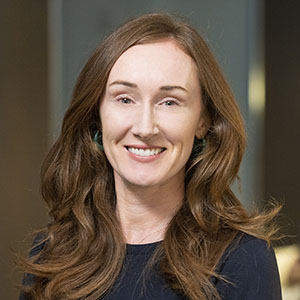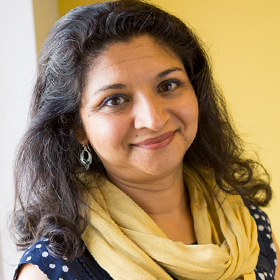Consider the trust fall. You and an acquaintance stand a few feet apart, single file. You’re in the front, back rigid, hands crossed over your chest. Feet firmly planted, you close your eyes and allow gravity to pull you backward. Like a solitary felled tree. In the span of a couple of heartbeats, you descend into darkness through a liminal space. It’s a surrender of control, a momentary trip through the unknown. Perhaps there’s a grimace or a giggle. Maybe a faint jolt of fear. Will your partner catch you or will you crash to the ground?
The concept of trust often takes this binary shape in our brains. All or nothing. You trust someone or you don’t. But trust isn’t an on-off switch, is it? It’s more of a dimmer switch that slides up and down along a spectrum in response to a host of variables. It’s constant calibration.
Perspectives from the Field
Sector leaders offer their reactions to this essay and their reflections on trust-based philanthropy.
- “There Is a Trust Gap in Philanthropy. Donors Can Help Close It.” by Shaady Salehi of the Trust-Based Philanthropy Project
- “How to Get Unstuck and Build Trust” by Kathy Reich of Ford Foundation BUILD Initiative
- “How Trust Works and To Whom It Is Owed” by Aaron Horvath and Micah McElroy of the Stanford Center for Philanthropy and Civil Society
- “Where Is the Heartbeat?” by Jara Dean-Coffey of jdcPARTNERSHIPS and the Equitable
Evaluation Initiative
In recent years, the opaque dynamics of that calibration within the world of philanthropy have captured the attention of the social sector. From where The Bridgespan Group sits, working closely with both the donors and the doers, that attention is a good thing. We’re beginning to see evidence of a shift from a culture of compliance and philanthropic control toward collaboration and grantmaking practices that recognize nonprofit leadership and expertise. The shorthand for this shift in today’s parlance is “trust-based philanthropy,” which the Trust-Based Philanthropy Project has most notably advanced.
Of course, it’s early days yet. The growing interest in this approach—which, to be sure, some funders have practiced for decades—has not come without controversy. We’ve heard fears that a lack of donor direction or control might overwhelm nonprofits and concerns that trust-based giving is riskier or less strategic. We’ve heard frustration at interpretations that “trust based” suggests all donors should act the same, that “trust” is an on-off switch and turning it on requires simply giving the money and asking no questions. (The Trust-Based Philanthropy Project, by contrast, lays out six specific trust-based practices but “invites practitioners to embrace a clearly articulated set of values” rather than concentrate on those practices.)
In this essay, we looked to other fields—the social sciences and for-profit investing—to shed new light on this discussion and the underlying assumptions guiding the relationships between donors and doers. How did we get here? Why have control and compliance donor practices proven so durable despite evidence that they often undermine impact? How can a more nuanced understanding of these dynamics help build the range of relationships that drive the most social change?
The first half of this essay focuses on the ways in which underlying assumptions about the value of philanthropic control have shaped where we are today. The second half provides an alternative for donors to consider as they seek to support the creation of value in the sector. We believe that the search for a single answer or approach to trust-based philanthropy eclipses a richer dialogue informed by the context of relationships—both their goals and history—and the relative knowledge, capabilities, and assets of each of the parties.
“[Trust] is extremely efficient. It saves a lot of trouble to have a fair degree of reliance on other people’s word.”
We’ll ask more questions than provide answers here. This piece is meant as a provocation for challenging our collective thinking. We invite curiosity, vulnerability, and a shift in mindsets. And we hope to engage others in that spirit of experimentation and learning from perspectives beyond our own. To that end, we invited a range of voices to critique and build on our thinking in a series of response essays, to continue to push and pull on these themes for the benefit of the larger social sector.
Is Trust About Letting Go of Control?
Trust is about getting results.
Trust is the connective tissue of human relationships. In its absence, there’s no community, no economy, no collaboration, no collective flourishing. Organizations, too, are bound together by trust, both formal and informal. The concept of trust has proven fertile soil for diverse scholarship, with overlapping definitions spanning the social sciences, from organizational psychology to economics.
As a simple distillation: trust is a measure of confidence that one party will deliver on the expectations of another. While one might view trust through a moral lens, our primary interest here is in trust as a rational and practical mechanism, one that mitigates risk in social systems and optimizes results. Trust is an invisible currency that facilitates transactions between two or more parties who need something from each other. “[Trust] is extremely efficient,” wrote Nobel Prize-winning economist Kenneth Arrow in his 1974 book, The Limits of Organization. “It saves a lot of trouble to have a fair degree of reliance on other people’s word.”
In an organizational context, greater trust tends to increase efficiency, support strategic adaptation, and improve information flows. In real life, trust is interwoven with hierarchical and market-based mechanisms; supervisors, contracts, policies, and standard operating procedures all shape relationships. Yet, extensive research has shown the benefits of trust in professional contexts, both within organizations and between them.
Within organizations, trust is an essential ingredient for team performance and organizational results, particularly when the goal is to solve complex problems. High-trust environments can also enable organizational “slack”—resources held in reserve, which are essential for innovation, adaptation, and renewal. Trust is also associated with lower staff burnout and stress and higher engagement and productivity.
In interorganizational contexts, trust influences direct economic outcomes, like lower transaction costs and increased sales. It affects relational outcomes, like increased strategic flexibility and improved information sharing. In short, a higher-trust environment can support the conditions for greater productivity and innovation, especially in complex and dynamic environments. There are several pathways of trust building. As with other patterns of human behavior and power structures, inequity and bias shape those pathways. (See “Three Pathways of Trust” below.)
A low-trust environment is a poor match for philanthropy.
Douglas McGregor’s seminal 1960 business management book, The Human Side of Enterprise, introduced a framework for understanding how assumptions and mindsets shape the design of organizations and approaches to managing people. McGregor presented two ends of a spectrum—Theory X and Theory Y. The two theories describe radically different beliefs about the motivations of workers and how best to create the conditions that produce the intended results.
Theory X is control-based. It involves micromanagement, short time horizons for deadlines, and incentives designed for predictable, tangible results. Theory X assumes workers have limited expertise and low motivation. Risk, in Theory X, is best mitigated by centralized, top-down control. In short, it’s a carrot-and-stick, low-trust environment.
Theory Y is decentralized and participatory. It assumes that when people take ownership of their work, they do it more effectively. Theory Y sees workers as motivated and capable. It recognizes worker expertise and encourages their responsibility and centrality in complex problem-solving. In short, it’s a collaborative, high-trust environment.
McGregor’s writing helped shape organizational design during the rise of the knowledge economy in the United States, which was a shift away from a “cogs in the machine” mindset, when even highly structured environments like engine manufacturing began adopting more of a Theory Y approach. The limitations of a “command-and-control” approach—Theory X—have been clear now for decades, yet it remains in operation in many places. You see Theory Y in the skunkworks approach to innovation or project-based learning in elementary school classrooms. More broadly, you see it informing the practices of many of the highest-performing organizations in the airline, retail, manufacturing, and service industries. In many fields, the evidence is compelling that a Theory Y approach leads to better outcomes.
In reading McGregor’s research and its application in other sectors, two things struck us. First is the similarity between the experience of workers in a Theory X environment and reflections nonprofit leaders share about their philanthropic relationships. Second is the inadequacy of a Theory X model for solving the complex problems that ambitious nonprofits and nongovernmental organizations seek to address. Command and control might work where a solution and a service are predictable and linear—think food banks and soup kitchens to help those experiencing food insecurity today. But Theory X falls short where solutions necessarily require complex coordination among interdependent systems—think policy advocacy and economic reforms to address the root causes of food insecurity.
The Theory X dynamic plays out as a familiar annual ritual in the social sector: Funders give resources with tight control mechanisms—single year, project restricted, with their own metrics for success. To secure funding, nonprofits work hard to comply with those grant terms, which inhibit investing in innovation or getting ahead of the growth curve. The terms also leave little buffer for inevitable business uncertainties. The ritual begins anew year after year.
At least one recent study uncovered the hidden cost of that labor—“norm-adhering nonprofits sacrifice about half of their mission impact over a 10-year period compared with norm-busting nonprofits.” Over time, the fragility of organizations and the limited bandwidth of leadership teams reinforce funders’ belief that without their intervention, nonprofits lack strategic discipline and would fall short of their intended impact. Socialized this way for decades, nonprofits can end up in a cycle of “learned helplessness.” And chronic fatigue from operating in an environment of scarcity further challenges their power and trust-building with donors. And the wheel keeps turning.
But why not create a Theory Y social sector? Its goals and performance potential would be far better aligned with both donors’ impact goals and our observations of nonprofit capacity to lead in addressing complex social issues. Observational data from organizations that have received dollars with fewer restrictions suggest this directional shift would unleash new energy, capability, and innovation into the sector. Bridgespan’s own research on the impact of Ballmer Group’s large, unrestricted, multiyear grants found that when nonprofit leaders have greater resource flexibility and agency, they can strengthen their organizations and leadership ranks and steward funds with strategic rigor.[1] These findings echo what the Center for Effective Philanthropy and Panorama Global have found through surveying and interviewing MacKenzie Scott’s grantees, who similarly received large, unrestricted grants.
If we are moving to a world in which the dominant mode of donor action is not control and compliance, then what is the appropriate role of the funder?
Is Trust About More Than Money?
Because we’ve had the privilege of being one of the advisors to MacKenzie Scott’s Yield Giving, folks often ask us, “Is that trust-based philanthropy—giving large amounts with no strings and no reporting requirements?” It’s absolutely one model, but it’s far from the only one. Trust-based practices can include a range of relationships. For example, single-year project grants are appropriate in some instances—think proof-of-concept work or critical, time-sensitive matching donations in moments of acute crisis.
And too often, discussions of trust-based philanthropy are reduced to grantmaking mechanics alone. Trust-based practices can go much deeper in the form of nonmonetary support. The Trust-Based Philanthropy Project often describes it as a deeper, values-driven approach that brings a lens of power consciousness not just to grantmaking but also to a donor’s culture, structures, and leadership. In our minds, the fullest expression of trust-based philanthropy’s goals is when it creates space for both parties’ relative strengths and assets to fully contribute toward a shared impact objective. Solving knotty, persistent problems—the core of social innovation—is a team sport.
How private investors offer their expertise
Since at least the early 2000s, some elements of private sector thinking have been ascendant in philanthropic practices, when funders began to think of themselves as “social investors” and “venture philanthropists” seeking “social return on investment.” Bridgespan played a role in mainstreaming some of this thinking. We’ve since learned that borrowing best practices from the private sector should be done with care. The incentive structures, goals, and measures of results in the private sector can be fundamentally different than those in the social sector. However, there is at least one for-profit investing practice that philanthropy hasn’t fully adopted and arguably should—applying consistent, value-adding, relevant capabilities to increase the impact of funding.
Successful private equity and venture capital firms have a clear understanding of their expertise and capabilities. That self-assessment guides both investment selection and the nature of ongoing engagement. Firms that seek to augment management’s ability to build a stronger, more valuable business often bring detailed value-creation strategies and significant expertise, either in-house or through their networks. Less-interventionist firms support entrepreneurs through thought partnerships on shared ambitious goals and ensure access to top management expertise matched to the organizations’ needs. Others, particularly venture capital firms investing in earlier-stage companies, serve more as connectors, making introductions to other investors for future funding.
Furthermore, private equity firms hold an asset for an average of four to five years and venture capital firms for an average of five to seven years. Committed investment over longer periods of time aligns the investor to longer-term goals including organizational sustainability—like the resilience and foundational capabilities that can wither in the common funding paradigm for nonprofits.
Let’s be clear: Private investors, in particular private equity firms, are not known for their wide embrace of Theory Y practices. They often place their own executives on leadership teams and impose key performance indicators and financial discipline on their portfolio companies—practices that resemble the common funding paradigm for nonprofits. Setting that aside, we’re highlighting how they understand their ability to add value.
How does this apply to donors? There’s room for all sorts of nuance in the donor-doer relationship when funders engage in an honest assessment of their assets and potential to create value beyond what nonprofit leaders can achieve on their own. In our experience, truly value-adding, high-intervention donor strategies are rare. But there is also plenty of low-hanging fruit.
In our earlier research on Ballmer Group grantees, we heard, again and again, the power of donors’ networks—both for introductions or confidence signaling to like-minded peer funders and for knowledge sharing among nonprofits pursuing related work or facing similar challenges. These are low-level interventions and often bespoke to organizations’ needs. We also have worked with nonprofits that find select donors to be important strategic thought partners—individuals uniquely skilled in asking questions that tighten strategic clarity, advising on explicit resource-allocation trade-offs, or troubleshooting supports for internal operational challenges.
More infrequently, when a donor has significant in-house expertise on a core field (like climate) or capabilities (like growth strategies and plans), we have seen examples where their involvement beyond giving has catalyzed a nonprofit’s trajectory. Again, to be clear, the higher level the intervention (that is, the more technical or the deeper the knowledge of the organization and its culture is needed), the rarer it is to find a donor with specific expertise greater than the professionals already on staff. Among the most critical lessons for donors seeking trust-based partnership is to question whether the choices they make are adding to—not taxing—impact. In general, donors tend to overestimate their noncash value-add. They also tend to vastly underestimate the expertise and capability of nonprofit leaders and the hidden costs of their capital.
Can We Change Our Mindsets on Trust?
“Mindsets are deep, assumed patterns of thinking that shape how we make sense of the world and what we do that can alternately normalize or problematize aspects of the existing social order,” wrote the authors of Mindset Shifts: What Are They? Why Do They Matter? How Do They Happen? “Displacing, shifting the salience, or stretching people’s deep understandings of the world is a massive lift. It doesn’t happen overnight, and it doesn’t happen without many different types of actions by many people.”
Shifting mindsets is a tremendous undertaking. It takes acknowledging and interrogating entrenched beliefs, being open to positive pressure, and being persistent. Many paradigms exist for rethinking the questions about donor-doer relationships that we lay out above. We’ve drawn on examples from the social sciences and for-profit investing, but there are at least as many that we haven’t explored.
Consider the role of faith traditions [2] and the concept of accompaniment. Consider the contributions of feminist theory in exposing paternalistic power structures and challenging philanthropy’s understanding of risk. We encourage any funder who aspires to move toward greater trust-based practices to find a paradigm whose application and questions prompt the kind of honest self-reflection—particularly around opportunities to shift power—that we describe above. We all should reckon with previously unchallenged, implicit assumptions that undermine the work of transformational social change.
There is no magical answer to the trust conundrum, no singular action that will find the optimal setting on that dimmer switch. Trust demands comfort with uncertainty. It’s risky and vulnerable. It’s far more complicated than that clichéd trust fall. We believe trust is also a critical facet of social impact.
We intend this essay to provoke rather than prescribe, to cultivate a deeper dialogue and collective learning that leads to collective action. Our own thinking is sure to evolve. In the spirit of conversation, we invited several thought partners to contribute their perspectives in response, to push and pull, to build, and to offer counterpoints. We hope you’ll take the time to explore their contributions.
Three Pathways of Trust
Trust building in donor-doer relationships is an inherently challenging exercise. There’s a fundamental asymmetry of dependence in the relationship: donors have many more options to apply their capital than doers have options to attract it. How often have we heard of a nonprofit choosing its funder versus a funder selecting or rejecting a nonprofit for its portfolio? This simple fact challenges trust: there is a natural human tendency toward control if you can possess it—particularly absent robust feedback loops that challenge your thinking and actions. In this environment, extra attention to equitable opportunities for trust building is critical.
Trust follows observable, well-trodden, familiarity-based patterns that sociologist Lynne Zucker suggests can be organized in three categories (as outlined below). Trust doesn’t emerge fully formed—it grows from thoughtful, deliberate exchanges that mutually benefit both parties. While each of these three dynamics is visible in the relationship between donors and doers, funders can look for places where their practices have resisted these patterns or shaped their practices in unproductive ways—after all, as the saying goes, there is “trust among thieves.”
Process-based trust is generated through recurrent transactions that demonstrate competence and commitment to expectations. Consider the common scenario of a longstanding donor-grantee relationship stuck in a Groundhog Day loop of single-year, project-based grants that come burdened with significant reporting requirements. Here’s a place where funders can honor process-based trust. Funders could give greater space to existing grantees through multiyear grant commitments, removing restrictions on fund use, increasing the size of grants over time, and shifting to the organization’s own success metrics in reporting requirements.
Institution-based trust works through a third party—the tendency to trust those who are trusted by those we trust. While some donors do lean on third-party trust, either from peer funders, external expert references, or accreditation entities like Candid, this appears to influence much more commonly who they fund rather than how they show up in that funding relationship.
Even when peer donors fund the same organizations at the same time or trusted institutional intermediaries indicate quality, grant terms and reporting requirements often remain limited or restrictive. Nonprofits are then left to navigate a thicket of only partially aligned requirements to pursue their strategy. To streamline demands on nonprofit leaders, funders could look for opportunities to leverage the perspectives and tools of peers and intermediaries to foster trust in their nonprofit partners. It’s worth noting here the emergence of collaborative funds, as these leverage the trust funders have in the fund intermediary to accomplish a set of goals.
Characteristic-based trust anchors on social similarity—a perception that both parties share common traits or markers. As calls get louder for more trust-based philanthropy, it’s important to recognize that similarity-based trust often amplifies funder biases and perpetuates the inequities of the status quo.
The natural dynamics of trust can be problematic. As Shaady Salehi of the Trust-Based Philanthropy Project has pointed out, funders in the United States are predominantly white and educated, from affluent backgrounds. Thus, characteristic-based trust can further disadvantage leaders of colors’ access to resources, particularly resources that come without the strings of significant donor control.[3] It’s critical for funders to be self-aware of this dynamic. Funders ought to reflect on their biases, create space for candid feedback, and hire more proximate grantmaking professionals. After all, the value of the characteristic-based trust that leaders of color have built with the communities they serve makes them especially effective at pursuing high-impact strategies.
Acknowledgments
Beyond the research cited within the document, there are several organizations whose work has influenced our learning and thinking. These include the Trust-Based Philanthropy Project, Center for Effective Philanthropy, and Panorama Global.





